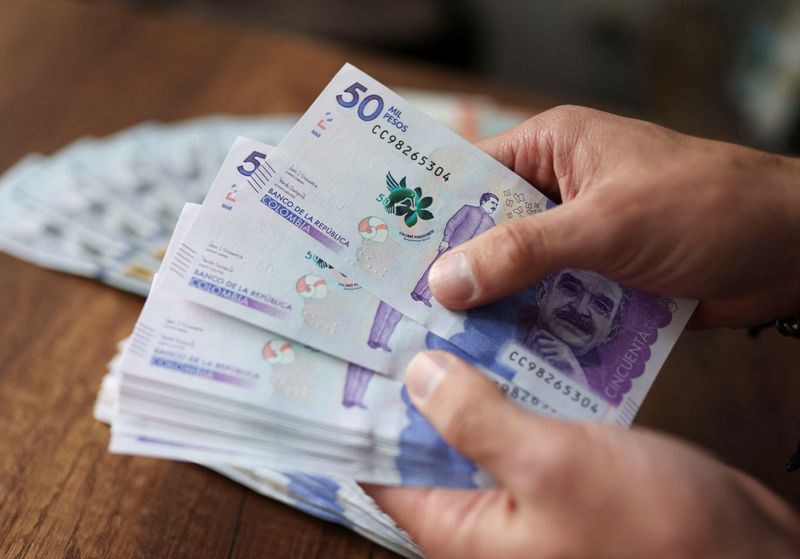By Rodrigo Campos and Marc Jones
NEW YORK/LONDON (Reuters) - From BlackRock to JPMorgan (NYSE:JPM), some of the world's top investors are upbeat on emerging markets for the second half of the year on the prospect of falling interest rates, while signs of progress in tricky debt talks are set to buoy frontier markets.
Positive headlines for developing economies, from inflation undershooting expectations to stressed markets such as Pakistan or Zambia making progress in shoring up their strained economies are giving the bulls hope.
Even if a July rate hike is still on the cards at the U.S. Federal Reserve, investors are expecting emerging markets to be resilient.
"The mood on emerging markets was absolutely too pessimistic," said Magdalena Polan, an economist at PGIM, saying the asset class had suffered from a shift in global risk aversion.
Recent emerging market inflation data has been a key driving factor in upbeat outlooks. Citi's EM inflation surprise index readings are undershooting estimates by a rate not seen since mid-2020 when demand fell off a cliff due to COVID-19.
"EM has made quite substantial progress in bringing inflation down already, and going forward we expect this to continue," said Manik Narain, a strategist at UBS.
This will allow some central banks, especially those who raised rates months before the Fed started its tightening cycle, room to lower them.
Both JPMorgan and BlackRock, the world's largest asset manager, are betting on the outperformance of local currency bonds across EMs.
Some emerging market central banks are ready and able to cut rates, said Wei Li, global chief investment strategist at Blackrock (NYSE:BLK) Investment Institute.
"Because of that, we actually have a preference for emerging markets over developed markets specifically highlighting local currency emerging markets," she said.
Latin America's Brazil and Chile could soon join Uruguay in starting a rate-cut cycle, with Mexico and Colombia waiting in the wings.
Hungary, the Czech Republic and others are seen following the same path, with overall cuts across high-yield and investment grade EMs outpacing both the United States and Europe, according to JPMorgan.
FRONTIER FORAYS
A number of smaller, riskier emerging markets have also seen a positive change in momentum.
Zambia - a test case for the G20 Common Framework for restructuring poor countries' debt - made substantial progress in debt talks after years of delays. Pakistan, struggling to fend off a default, secured a $3 billion deal from the International Monetary Fund. Nigeria embarked on an ambitious reform programme.
Many of these so-called frontier bonds might not make the top 10 holdings of emerging market portfolios, but seeing meaningful progress - especially in tricky debt talks - bodes well for other restructuring cases such as Sri Lanka or Ghana, and emerging markets more widely, said fund managers.
"Zambia, Ghana, Sri Lanka - if we can get these across the line in 2023, I think it would be beneficial for the wider market," said Carl Ross, partner at investment firm GMO.
Returns on hard-currency bonds of Zambia and Sri Lanka - but also those of Argentina and Ukraine - are well into the double digits this year. El Salvador's are 58%.
THE DRAGON IN THE ROOM
The positive outlook for emerging markets in the second half of 2023 - and the year to date performance - comes with a China-sized asterisk.
In stocks, a rally that started mid through the fourth quarter of last year on the back of China's reopening petered out as the economy failed to live up to expectations. Investors also worry that if China were to cross a line with Taiwan, Western sanctions could make the world's second-largest economy uninvestable -much like it did with Russia after it invaded Ukraine.
The evidence is in performance, with the overall emerging markets stock index up 3.4% so far this year, compared to the 8.3% increase in the Bloomberg emerging markets ex-China index.

Flows to both debt and equity instruments have also shown a large split: through the first five months of the year, net foreign portfolio flows to China have been a negative $4 billion, compared to a positive flow of nearly $120 billion to the rest of the EM universe, according to data from the Institute of International Finance.
With that backdrop, it's not surprising that the Chinese yuan is among the weakest EM currencies this year with a near 5% decline against the U.S. dollar. Meanwhile currencies in Brazil, Hungary and Mexico are at or near double digit gains to the greenback, with Colombia's peso the top performer with a 16% gain.